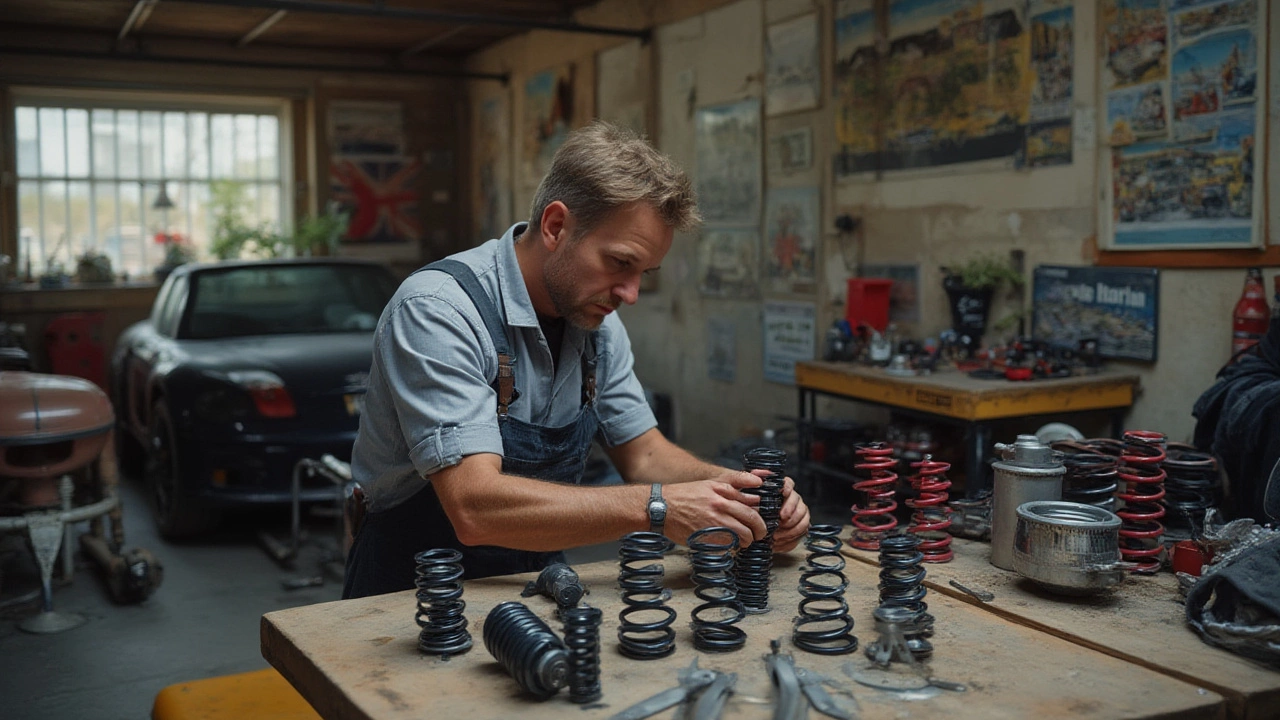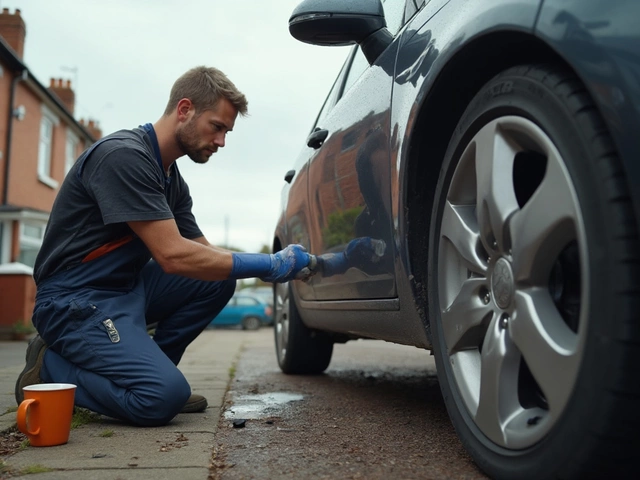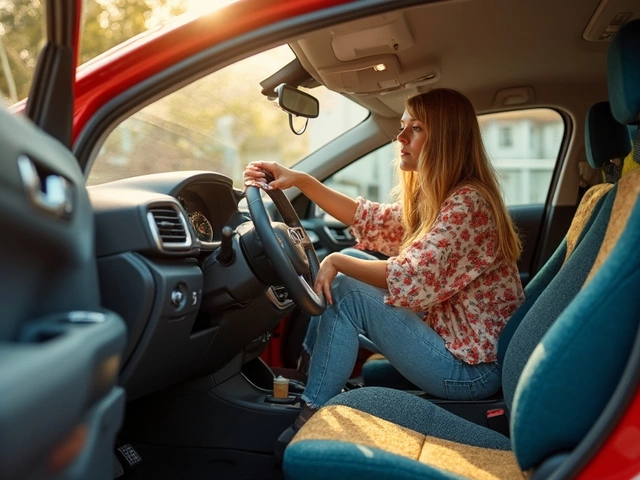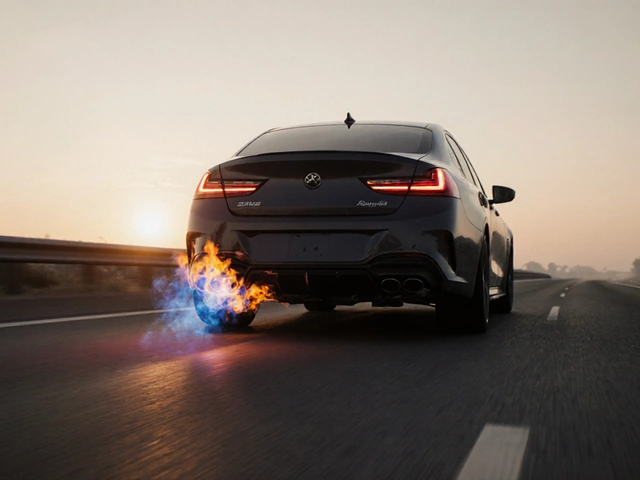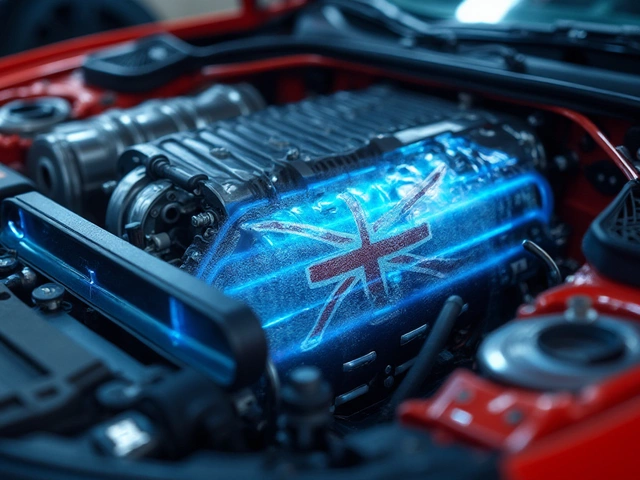You can spot a car guy in two seconds: his pride and joy sits perfectly low, tires tucked just right under the fenders. Nothing says passion like a carefully dropped suspension that looks good and drives even better. But here’s where it gets real—drop it wrong, and your car’s either a pogo stick or a bumpy grocery cart. Most people jump in without knowing what's really happening between their tires and the street. It’s not just about looks; your choice between coilovers or lowering springs will change how your car feels every time you grab the wheel. So, do you want crispy handling, daily comfort, or simply a mean stance for cars and coffee? Let's get down to what matters.
The Basics: What Are Coilovers and Lowering Springs?
Every car geek has heard these words tossed around, but what’s actually going on? Lowering springs are exactly what they sound like—replacement springs that shrink the gap between fender and tire. Most kits will swap into your car’s stock shocks and struts. Springs are coiled stiffer and shorter, so your car sits lower right out of the box. Drive into any parts shop and you’ll see boxes stacked with spring kits for popular Aussie cars—the WRX, MX-5, Commodore, Golf GTI—all with the promise of a more aggressive rake and a firmer ride.
Coilovers, on the other hand, are like the Swiss Army knife of suspension. It’s an entire package: spring, shock absorber, mounts, and often adjustment hardware. You get threaded bodies or collars, let you dial in ride height millimeter by millimeter, and sometimes damping controls—turn the knob, and you go from back road rigid to city soft in seconds. Unlike springs, coilovers replace more of your factory setup, so it’s a bigger change, but with tons more control. Big name brands like Tein, KW, and BC Racing offer kits tailored to street, track, or slammed street stances. If you want the car to sit low enough for a mag shoot but also survive the drive into the office car park, coilovers give you options.
This all sounds pretty straightforward, but here’s the thing: these two options don’t just change how your car looks. They control bounce, absorb pothole shock, affect tire life and braking, and influence safety. They're not simply about “going low”—they’re the foundation for how your car communicates with you, and what you’re able to do behind the wheel.
Performance on the Road: How Each Setup Really Feels
Let’s get honest: most people dream of perfect stances but don’t think about the daily grind. So, how do each of these options actually change your driving? Lowering springs drop your car by 20mm to 50mm usually, keeping things simple. The good: upgraded springs nix a lot of the stock suspension’s floaty feel—think crisp, direct, less body roll when cornering through the hills near Mount Glorious. Your car reacts quicker and feels more like it’s part of you. If you’re just after less wheel gap and more style, springs are fast, cheap, and easy.
But, the devil’s in the details. Factory shocks aren’t made for short, stiff springs, especially on bumpy city streets in places like Fortitude Valley. You’ll feel more of the road—good for enthusiasts, rough for everyday school runs or long Gold Coast commutes. Over time, stock dampers wear out faster, leading to a wobbly ride and “blown shock” bounce. Lowering past 40mm? It gets harsh, with trouble over speed bumps and at driveways. And you can’t dial this setup up or down—it’s fixed until you swap the parts again.
Coilovers flip the script. Their main party trick is adjustability. Want higher for Queensland floods? Spin to raise, done. Dropping to the ground for a photo shoot? Just twist. You control how comfy or stiff the drive is, and decent kits let you adjust rebound and compression with a little clicker under the bonnet or near the wheel. On track days—think a day at Queensland Raceway—you stiffen things up for sharper cornering, then soften it for cruising home.
There’s more, though. With coilovers, you can usually corner-balance the car. That means your left and right wheels get load distributed just right, which is next-level precision for handling. Coilovers also fit custom needs—different spring rates, camber plates up top for wheel alignment finesse, and hardware for rough terrain or race use. But it costs good money and takes time to dial in. If you just want a quick look, coilovers may be overkill.
| Feature | Lowering Springs | Coilovers |
|---|---|---|
| Price (AUD) | $300-700 | $1,200-3,500 |
| Ride Height Adjustability | Fixed | Fully Adjustable |
| Install Time | 2-4 hours | 4-8 hours |
| Daily Comfort | Moderate | Adjustable—from soft to stiff |
| Performance | Better than stock | Best—with adjustability |

Cost, Maintenance, and Longevity: Getting the Most for Your Buck
The cost question splits most buyers: are coilovers worth the price over springs? Let’s crunch numbers. Decent lowering spring kits hover around $400–$700 for popular cars in Australia. If you do it yourself, add a few mates, a jack, and you’re set for a cheap improvement. Installation takes a Saturday, and if you need a shop, expect another $500–$800 for labour and a wheel alignment. You use your existing shocks—great if they're fresh, risky if they're old because they might fail early. When they go bad, you’re looking at another round of spending for replacements. Most lowering springs last over 80,000 km, and are relatively maintenance free. But the rest of your suspension—bushes, bearings, ball joints—could cop extra stress, especially if you slam the car hard.
Coilovers are up front expensive. Expect $1,200 for basic street kits, or $2,000+ for adjustable, racing, or high-end road setups. Brand matters—a set from XYZ or MCA Suspension here in Queensland isn’t the same as a no-brand eBay buy. Installation gets technical, especially with height and damper settings, so most folks pay a mechanic. Then, add an alignment, and that’s another few hundred. If you don’t know what you’re doing with preload and damper settings, you can actually wind up with a worse ride, so getting professional setup is smart. But when it’s done right, your car will ride and handle beyond what lowering springs can deliver, especially if you plan to tweak settings for different driving.
Maintenance is different, too. Springs only need attention if you hear weird noises or notice sagging. Coilovers—because they have threads exposed to rain, dust, Brisbane sun—need to be kept clean and greased. Left alone, they can seize up, leaving you stuck at one height and watching your hard-earned adjustability disappear. Some coilovers need rebuilding every four or five years, depending on how aggressive you drive and how many pothole backroads you punish. That adds to the long-term cost but keeps things tight. A properly maintained coilover setup, though, will outlast most spring setups, and when parts do wear out, you can usually swap just the bits you need, not the whole thing.
Insurance and legalities sneak in here. Coilovers and springs should have ADR (Australian Design Rules) compliance certificates to stay legal. Slam your car too much without paperwork, and you risk cops, fines, defects, or worse, insurance void if you crash. Check with your insurer and the QLD transport authority—don’t just buy the lowest price kit off the internet.
- Coilovers shine if you want tuning freedom, max performance, or future-proofing for bigger wheels or more power.
- Lowering springs save money, time, and keep things simple—but only if you’re happy with the fixed ride height and a bit more firmness.
Choosing What’s Right: Tips for Picking Your Suspension Drop
So, which should you put on your car? It honestly depends on what drives you (and where you drive). If you want a clean look for car meets, daily comfort, and only a slight drop, lowering springs nailed to fresh shocks make good sense. They keep the budget in check and installation’s a breeze. Most family sedans, hatchbacks, or daily SUVs picked for better looks use this route. Just remember—the drop height is locked in, and the ride will get firmer but not punishing if you go mild.
But if you’re the type swapping wheels every summer, heading for weekends at Lakeside Raceway, or plan to up horsepower down the track, coilovers are where it’s at. Adjustable ride height lets you match new tires and loads, set your stance for every season, and tune the ride how you want. If potholes bug you, keep it soft; want more corner speed— crank it up. Good coilovers adapt as your car evolves, and you won’t outgrow them when your driving goals change.
A few tips from mates around Brisbane who’ve tried both:
- Measure how low you really want; 30mm (about 1.2 inches) is perfect for clearing most speed bumps, parking ramps, and still looking great.
- Don’t go budget on suspension—brands with real engineering, local support, and proven track records cost more but save headaches for years.
- If you daily your car and rack up kilometers, check reviews about long-term noise, comfort, and shock wear for your model.
- Always get a full four-wheel alignment right after any suspension swap—it keeps tires happy and steering true.
- If you buy coilovers, keep the threads clean (a toothbrush and some lithium grease does wonders) and work them up and down every few months to prevent seizing, especially during humid Queensland summers.
- Ask mates to ride in their dropped cars—nothing replaces first-hand butt-feel before you spend cash.
Your setup should suit your lifestyle, not just your Instagram feed. Whether you go for a set of lowering springs or splash out for coilovers, both offer a big step up from factory float. Weigh your budget, think about your local roads (Brisbane’s getting worse, not better), and be honest about how much tuning you want. Your car, your rules—just make sure the smile on your face lasts longer than the first roundabout.

